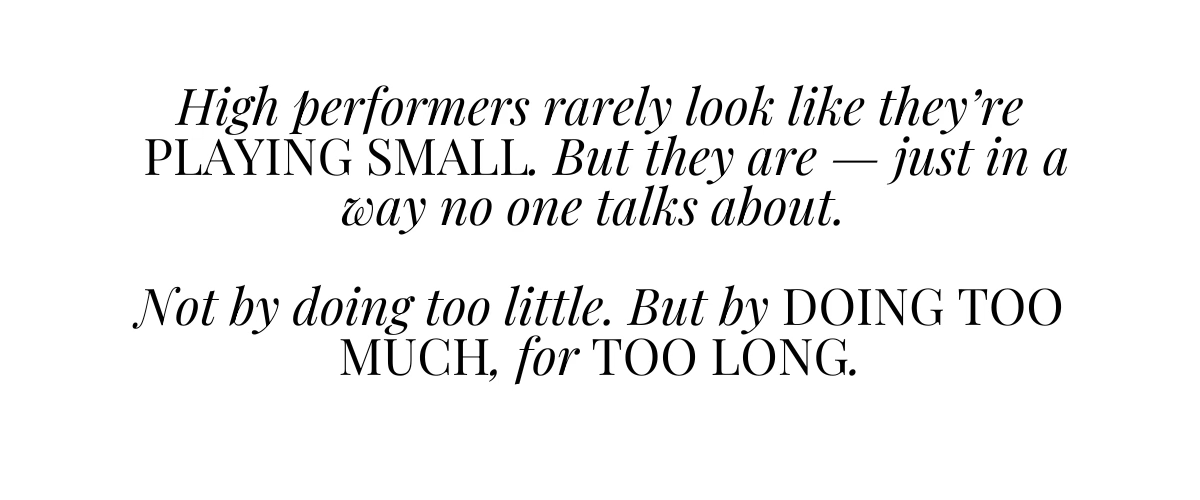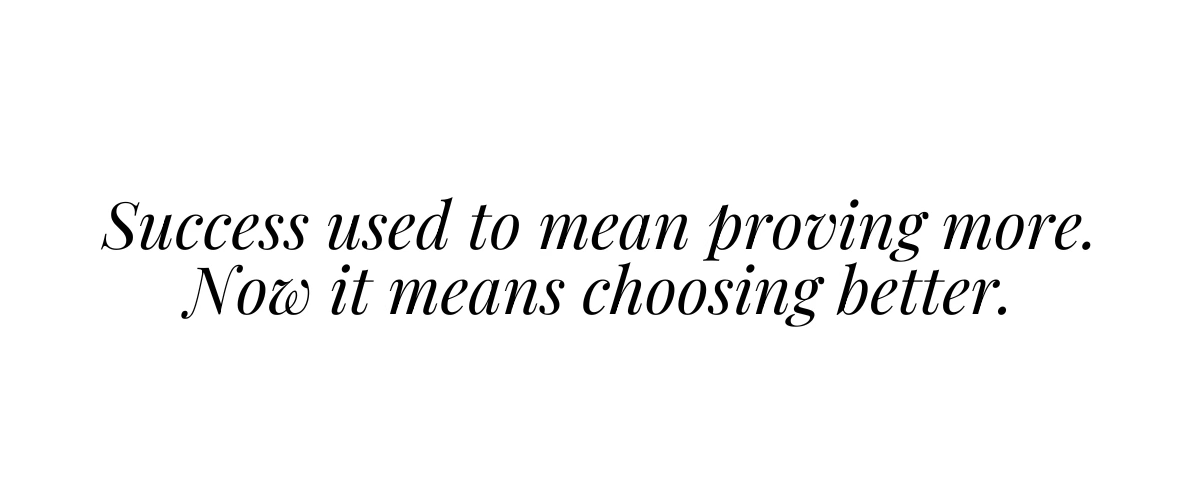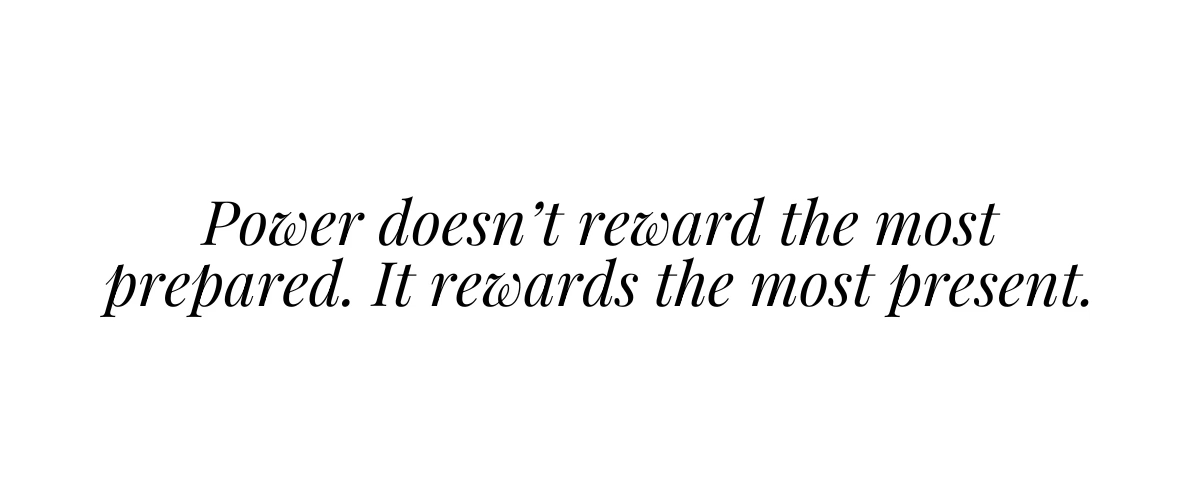6 Ways You're Selling Yourself Short at Work
Six habits that make you look effective but keep you stuck and what to do instead.
THE SCENE: STORY TIME
I believe high performers are often driven more by conditioning than clarity. The pressure to prove, to please, and to perform becomes second nature. And because they deliver, the praise keeps coming.
Until it doesn’t.
One theme that keeps surfacing in my coaching is choice—the quiet, daily decisions we make about how we show up. The choice to take on more than we can handle.
The choices we feel empowered to make. The ones we make on behalf of others.
Many of those choices don’t even register as choices until something breaks.
I’ve seen this in clients at every level and I’ve lived it myself.
In hindsight, the pattern is always clear: when we over-function, we under-lead.
When we don’t pause to ask, “Is this the best use of me?” we end up overcommitted, under-recognized, and quietly off-track.
High achievers can carry a lot without breaking. That’s the problem. You only notice what it’s cost after you’ve already paid the price.
There was a stretch in my career when I looked like a top performer on paper.
Every deadline hit. Every project delivered. Every expectation exceeded. Every box checked.
But emotionally? I was a slow-moving storm.
I was a bulldozer. I was reactive. I was carrying the weight of everyone's work and letting them know it, with a tight smile and snippy feedback. Sometimes I confronted people. Sometimes I didn’t. But I always carried the tension like a badge: See how much I care? See how hard I’m working?
And naturally, I vented. Behind closed doors, I had an entire shadow campaign going: subtle complaints, side-eyes, long Slack messages (some drafted and unsent lol).
What I didn’t realize at the time is that I was trading emotional steadiness for urgency, control, and intensity. And that trade wasn’t neutral.
It left a wake.
I was getting results, but at the expense of building trust. I used to think that getting results justified everything. But what I’ve learned and what I’ve seen in client after client is that how you deliver becomes part of your reputation. Not just your outcomes, but your energy.
And yes, I’ll say the quiet part out loud: for underestimated groups navigating this graciously is tricky.
You’re told to be clear, but not cold. Direct, but not harsh. Confident, but always humble. You overcorrect. You overcompensate. And then you wonder why you’re exhausted, frustrated, and still feel like you’re not being fully seen. Yes, very America Ferreira in Barbie vibes.
It’s infuriating. It’s unfair. And yet, in the right environment, with the right awareness, the balance is not impossible to achieve.
THE FRAMEWORK: THE PATTERNS AND WHAT WORKS
How to Stop Underselling Yourself at Work
Let’s talk about the most common trades high performers make and how to start making different ones. These are patterns I’ve seen in clients who are stuck, stretched thin, or consistently running into friction at work. Habits that feel like they meet the bar for excellence but over time, chip away at your influence, clarity, and energy.
Before I get into the list, I want to name something: conventional advice on this topic is often oriented around blame → what someone else did to you, what a boss failed to recognize, how a system let you down. But that lens only takes you so far.
The real growth starts when you shift the frame inward. When you stop keeping score and start owning your choices. Because once you do that, what others did or didn’t do starts to matter a whole lot less.
The frame of “trading” matters here.
Because when you're wired to do, to deliver, or to outperform, you don’t always realize you’re making a choice. You think you’re being responsible. Or resilient. Or even strategic.
As you move through this list, don’t just nod along—track your trades. Where have you been giving away power without even realizing it?
1. Trading Leadership for Self-Sacrifice
This is the most common mistake I see high-achievers making.
Maybe you don’t want to be a burden or you’re proud of being the one who “just gets it done”. But that quiet self-sufficiency? It doesn’t always boost your credibility.
Being the person who never needs help doesn’t just make you indispensable—it makes you (and your needs) invisible.
Power isn’t in being superhuman. It’s in knowing what you need and asking for it directly and without apology.
2. Trading Being Right for Being Effective
Alright, lean in for this one because I’m about to rip the bandaid. Optimizing for “right” isn’t always right strategy.
You show up prepared. Your deck is tight. Your points are bulletproof.
And….you assume logic will win. Because it’s right. Because it’s clear. Because it’s backed by data.
But research shows that simply sharing facts or the right way to do something almost never changes minds.
I’m a fan of Charles Duhigg’s work—especially his insights in Supercommunicators. He talks about how real persuasion starts with understanding what matters to the other person. What they value. What they fear. What they’ve experienced.
The goal isn’t to convince, it’s to connect. To connect with the people in the room, you’ll need to ask deeper questions like:
Why is this so important to you?
What are you worried about if this doesn’t work?
Once you understand where someone’s beliefs begin and end, then you can find common ground and move forward together. Sometimes being effective is about leading with curiosity and listening for what matters before trying to change it. Note: this doesn’t always mean you have to change your plan.
Want to be compelling?
Don’t just make your case. Ask better questions. Because real influence doesn’t live in your logic. It lives in your ability to make someone feel seen and then move with you.
In case you missed it: I wrote about how to lead with curiosity here →
3. Trading Progress for Perfection
You tinker. You revise. You wait until it feels airtight. You do this because you’ve probably been told your whole life that excellence is in the polish. Being excellent when the bar is often mediocrity IS an edge.
What trips high-achievers up is when you use perfectionism as a disguise for fear. Aiming for perfect isn’t always about having high standards. It’s about the fear of failure, of putting something out there that isn’t successful, or delivering something that doesn’t meet someone else’s expectations.
Meanwhile, someone else with half the prep already shared their idea. Took the shot. Got the credit. And let’s be honest, sometimes? Delulu is the solulu.
Sometimes perfection is just a way of hiding. Progress is a way of leading. Launch it messy. Speak before you’re 100% sure. Hit send while your voice is still shaking. That’s how you build momentum.
4. Trading Adaptability for Rigid Expectations
You read the books. You follow frameworks. You implement a new process the “right way”. And yet, it’s not landing. Your team is confused. Disengaged. Sometimes even quietly resisting.
You can’t figure out why. After all, you followed best practices to the letter. But remember, best practices are frameworks, they’re guidelines. They are not surgical procedures. They work best when applied in a way that fits your specific context.
Don’t be the person who asks their team to read a whole book on change management before initiating a change. Spoiler alert: they don’t want the theory. What they want is direction and guidance, framed by your expertise.
When you cling too tightly to how things should be done, you lose sight of how things actually work in this moment, with these people. Power is adapting in real-time, not treating theories and frameworks like rule books.
5. Trading Priorities for Problems That Aren’t Yours
High achievers are wired to solve things. So when a problem pops up—any problem—you jump in. You troubleshoot. You rework the doc. You follow up on the thing no one else circled back on. Not because you’re trying to control everything, but because it feels easier to just fix it than to sit with the discomfort of it not being solved.
And bit by bit, your focus fragments. Your calendar fills. Your brain becomes overstretched. You start to react more than you lead. You tell yourself you’re being helpful. But what you’re really doing is trading strategic focus for over-involvement.
Not everything broken is yours to fix.
Not every fire deserves your water.
Power is knowing which problems are yours and which ones aren’t.
6. Trading Growth for Grudges
It starts with one issue. You bring it to someone who gets it. They’ve had their own version of the same frustration. You both feel seen. The next time something goes sideways, you go back to them. They do the same with you. And without meaning to, you build a feedback loop—a shared lens where everything at work becomes annoying, broken, or unjust.
Venting becomes the culture.
It feels validating. It is cathartic. Incredibly so. I love a good vent sesh.
But here’s where it gets tricky: when you only seek out agreement, you lose perspective.
You stop asking what’s worth your energy and start believing everything deserves it. And the more time you spend naming the problem and fixating on everything that’s wrong, the less time you spend solving it.
Instead → Keep your people. Blow off steam when you need to. But diversify your inputs. Make sure you have voices in your life who will tell you the hard truths, challenge your patterns, and help you zoom out. Because if you want to grow, validation isn’t enough, you need elevation.
Power is knowing the difference between a safe space and creating spaces that keep you stuck.
THE WRAP UP
You don’t always realize you’re trading away what matters. But the fix isn’t more effort.
It’s better choices.
My advice is to be more intentional with what you give away. And more protective of what you keep.
Good luck. See you next week!
Ashley
NEXT UP
Next week: I’ll take you inside the Power vs. Performance Paradigm—a lens for understanding why some cultures reward influence, while others trap high performers in endless tension and output. If you’ve ever felt like you’re playing the wrong game, you’re probably not imagining it.
If any of these trades felt uncomfortably familiar, it’s not just you. You also don’t have to figure out the shift alone either.
LEVEL UP
Work with me
You don’t need another mindset shift. You need a different way of operating.
If the patterns in this piece hit home and you’re ready to stop trading your time, clarity, or influence for things that aren’t serving you anymore, let’s talk.
I work with high performers who are done over-functioning and ready to lead on their own terms. Clients describe working with me as having their own personal strategist—someone who sees the pattern, names it, and helps them move.
Ready to have me in your corner?
Click here to learn more about my program →
SUPPORT MY WORK
Subscribe and share
→ If this post resonated, do me a quick favor: tap the heart below (it takes 2 seconds) or share my work with a friend.










Ooof “it feels easier to just fix it than to sit with the discomfort of it not being solved.” 🔥
Always just absolutely NAILING it. 👏👏👏